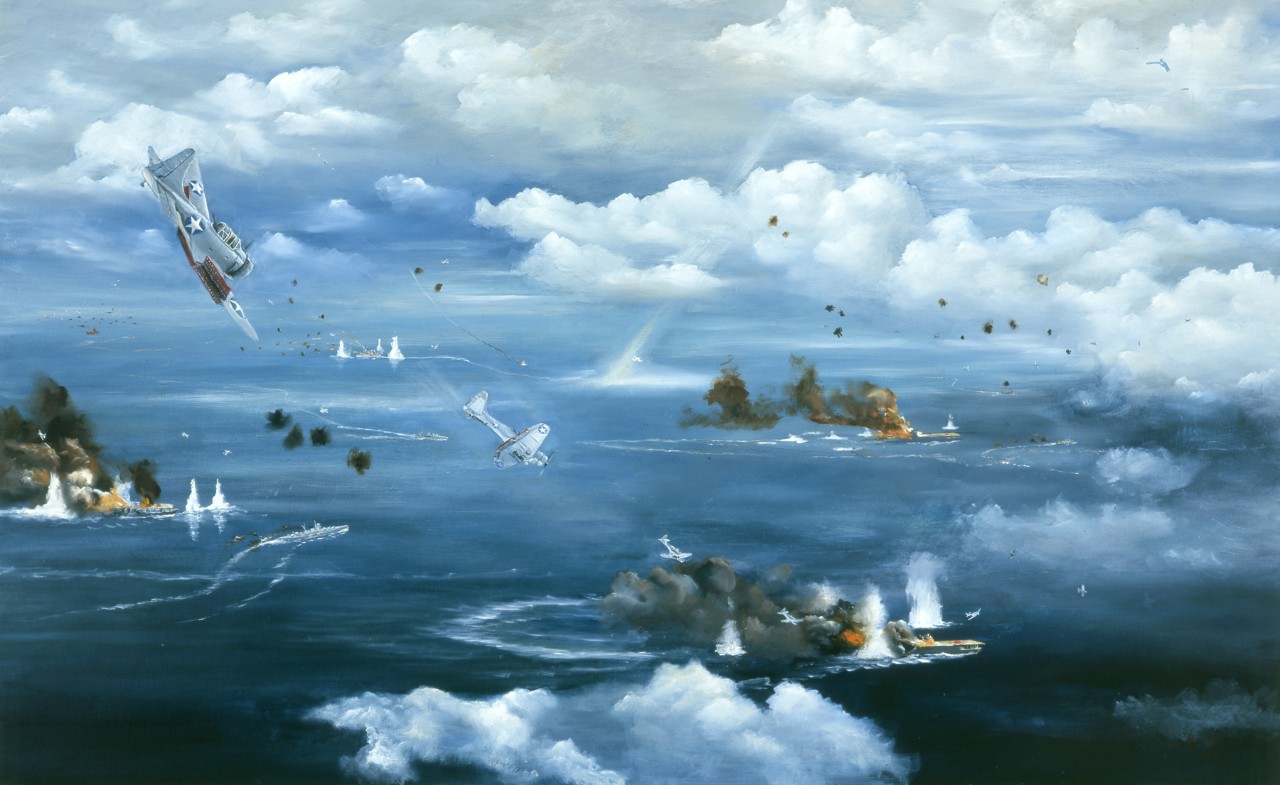Aim for the Flattop!
Enthusiasts of naval history might know that the aircraft carrier made the big-gun battleship obsolete: the air wing's extreme range advantage over big guns coupled with inherent speed of an aircraft carrier (because it needed to provide "wind over deck" to enable its air wing to take off and land) meant that a battleship might never be able to return fire before it was sunk. But in World War II the Imperial Japanese Navy's plan for the Battle of Midway was to destroy the US Navy's aircraft carriers primarily by the gun power of its battleships. The result was the sinking of all four Japanese aircraft carriers assigned to the operation, but in a way that surprised me.
 |
| The moment the Kidō Butai realize they're having a Bad Day |
I first read Shattered Sword in 2021 at the recommendation of Dr. Bret Devereaux at his blog "A Collection of Unmitigated Pedantry" (ACOUP). I've mentioned it before regarding the deterrence effect of a mobilized defense industry. As I was reading it, my background understanding was that World War II proved the obsolescence of the big-gun battleship and the superiority of the aircraft carrier. So I expected destruction to rain from the skies onto vulnerable ships. But for the first several encounters between US aircraft and Japanese carriers (the US having found Japan's carriers long before the Japanese found the US'), the Japanese repelled the attacks with negligible damage.
The Failed Attacks
The Battle of Midway was orchestrated by the Japanese Navy to draw out and destroy the US Navy's aircraft carriers. The Japanese (erroneously) thought that the US would be reluctant to fight and so needed to be forced to defend Midway. In addition, Japan separated their aircraft carriers and battleships to present the carriers as a more vulnerable-looking target. The main elements involved in the battle were:
United States Navy
- CV-5 USS Yorktown
- CV-6 USS Enterprise
- CV-8 USS Hornet
Imperial Japanese Navy
The Kidō Butai
- Akagi
- Kaga
- Sōryū
- Hiryū
Through the morning of 4 June 1942, elements of the US Navy, US Marines, and US Army Air Force made several attacks against the Kidō Butai. These included:
- A mixed force of 10 torpedo bombers from Midway island
- 16 dive bombers from Midway Island
- 12-15 heavy bombers from Midway Island
- 11 dive bombers from Midway Island
- 15 torpedo bombers from USS Hornet's VT-8 squadron (the carriers finally enter the fray)
- 14 torpedo bombers from USS Enterprise's VT-6
- 12 torpedo bombers from USS Yorktown's VT-3
At this point I've read 11 chapters, I know that the US wins the Battle of Midway, but I am really wondering about whether airpower was all I had previously thought. Seven individual attacks all dealing minimal damage, almost all repulsed with heavy losses? It turns out that my impression of "weak airpower" was about to be greatly reversed.
The Successful Attacks
A brief moment here to acknowledge Parshall and Tully's humorous opening to chapter 12, which reads, "We pardon our readers for having turned the previous page with the understandable expectation of finding Dauntlesses [dive-bombers] hurtling downward from the heavens, only to discover that a brief but necessary piece of business remains before we get to the 'exciting part.'" I'll skip to chapter 13.
The first Japanese carrier to be hit was the Kaga. After the first 500-lb bomb did non-critical damage, "The seventh plane planted its bomb almost directly on the forward elevator, smashing it down into its well and then detonating in the fighter stowage spaces." (page 392). Then another bomb hit adjacent to the command center. Sōryū took a hit to the boiler room and lost propulsion. Akagi took only one hit, but that hit was a 1,000-lb bomb which "sliced through the flight deck and exploded in the upper hangar in the midst of the kankō [bombers] parked there." (page 404) So now three of four Japanese carriers had each taken at least one bomb hit.
This is where the devastation started. If you have any fear of fire or too vivid an imagination, I recommend reading this book but only skimming chapter 14 (and other parts thereafter). The fires started in each of the three carriers' hangars doomed each ship. Although the fire-fighting would take hours, ultimately all three ships were lost with heavy casualties.
The Japanese successfully launched an attack on the Yorktown, although it survived several torpedo hits (it was later sank by a submarine while en route to port). In exchange, the two battle-ready US carriers launched strikes on the surviving Hiryū (using elements from all three carriers' air groups) and gave it the same bombs-fire-destruction experience as the Akagi, Kaga, and Sōryū.
Conclusion
Like so many inflection points, the attacks on the Kidō Butai seemed to make no difference...until they suddenly they changed the course of the battle. In many tabletop and computer games, units have a set amount of armor or integrity that must be worn down, and then the unit suffers "critical existence failure". In reality, a unit might be completely undamaged until that one hit that makes it combat ineffective, or even destroys it outright. A reminder that the aircraft carrier / air wing weapons system became dominant for a reason, but also a reminder of its vulnerability.

Comments
Post a Comment